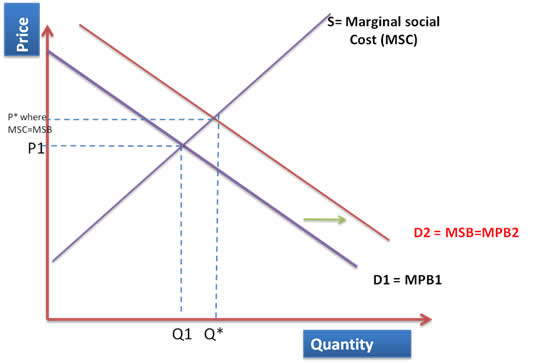What is Market Failure?
In a market where there is equilibrium, the resources are allocated in the best possible manner and there is 'allocative efficiency'.
Allocative efficiency is when situation where Marginal cost is equal to Marginal revenue.
However, this is not possible in the real world. Market failure exists when the resources are not allocated efficiently. Community surplus is not maximised and thus there is market failure. From a community's point of view, producer surplus is not equal to consumer surplus.

Market failure is thus caused by
- Abuse of monopoly power
- Lack of public goods
- Under provision of merit goods
- Overprovision of demerit goods
- Environmental degradation
- Inequality in distribution of wealth
- Immobility of factors of production
- Problems of information
- Short termism
Externalities
Externalities are a loss or gain in the welfare of one party resulting from an activity of another party, without there being any compensation for the losing party.
This activity can be due to consumption or production of a good or service.
If the third party suffers due to this activity then it is known as negative externality.
When the third party gains from this activity is it known as positive externality.
Marginal Private Benefit is the benefit which is derived by private individuals in the consumption of a good or service.
Marginal Private Cost is the cost of producing, specifically marginal costs, which are incurred by private individual while producing a good or service.
Marginal Social Cost is the total cost to society as a whole for producing one further unit, or taking one further action, in an economy. This total cost of producing one extra unit of something is not simply the direct cost borne by the producer, but also must include the costs to the external environment and other stakeholders.
The market demand and supply curves therefore reflect the MPB and MPC accruing to buyers and sellers.
When there is no externality then the intersection MPB (demand) curve and MPC (supply) curve determine the equilibrium price. The price and quantity reflected at this point are ‘socially optimum’ level of production or consumption and the market is said to have allocative efficiency.
i.e. MPC=MPB.
At this point the consumer surplus is equal to the producer surplus.
However, this is usually not the case in real world. The production or consumption of goods and services do produce externalities and thus the concept of Marginal social benefits and Marginal social costs comes into being.
MSB=MPB+Externality
MSC=MPC+Externality
Types of Externalities
Externalities can result either from consumption activities or from production activities
There are four types of Externalities
1. Negative externality of Production
2. Negative externality of Consumption
3. Positive externality of Production
4. Positive externality of Consumption
Negative Production Externalities

Corrective Negative Production externalities
Legislation and regulations
- Limit the emission of pollutants by setting limits to the extent of pollutants produced by a firm.
- Limit the production to a certain level.
- Force polluting units to install technologies which reduce emissions.
Putting Taxes
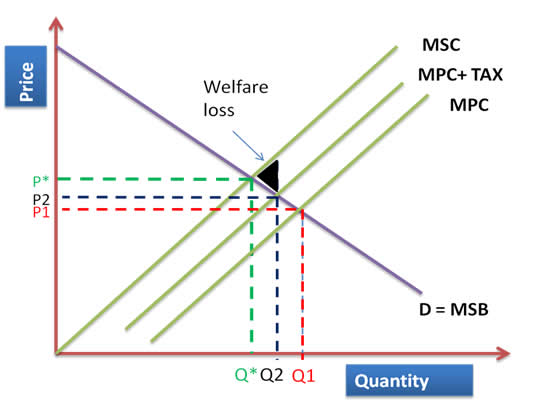
Tradable permits
Tradable permits are a cost-efficient, market-driven approach to reducing greenhouse gas emissions. A government must start by deciding how many tons of a particular gas may be emitted each year. It then divides this quantity up into a number of tradable emissions entitlements - measured, perhaps, in CO2-equivalent tons - and allocates them to individual firms. This gives each firm a quota of greenhouse gases that it can emit over a specified interval of time. Then the market takes over. Those polluters that can reduce their emissions relatively cheaply may find it profitable to do so and to sell their emissions permits to other firms. Those that find it expensive to cut emissions may find it attractive to buy extra permits. Trading would continue until all profitable trading opportunities had been exhausted.
Tradable permits will result in firms to lower the quantity of goods produced so that it equals Q* and to raise the price of the goods.
Watch a Video
Negative Consumption externalities
Negative consumption externalities occur due to consumption of certain goods and services.
Example, smoking. By smoking in public places, the consumer is creating negative externalities, in the form of passive smoking, for non-smokers. Other examples include using fossil fuels that pollute atmosphere, playing loud music and disturbing neighbours, discarding garbage in public places.

In negative consumption externality, the MPB is not reflecting social benefit and thus MSB lies below MPB. The vertical difference between MPB and MSB is the negative externality. The optimal level of consumption is where MSB=MSC i.e. Q*. However the negative externality is being ignored and thus there is an over consumption of the goods at Q1.
Correcting negative consumption externalities
Advertising: Government can using persuasive advertising/awareness campaigns to alert the consumers and influence them reduce their consumption. This will lead to a shift of MPB curve to the left thus reducing the gap between socially optimal level of consumption Q* and Q1.
Legislations and regulations: Government can also pass legislations or impose fines on certain activities which create nuisance for the societies. Many countries already have banned smoking in public places.
Imposing indirect taxes: By putting taxes on the production of goods that cause negative consumption externalities, government can reduce the supply. By putting taxes, the supply curve(MSC) will shift upwards to MSC+tax. This will reduce the gap between Q* and Q1.
Watch a Video
Positive Production externalities
These are positive externalities created due to production of certain goods and services. Examples include, when firms train their employees which result in better manpower or invest in research and development and succeed in developing new technologies which benefits the society.
Due to the fact that positive externality is produced, the MSC lies below the MPC. The diagram below illustrates positive production externalities. As we can see that the social optimal level of production of these goods should be Q* , however there is underallocation of resources and thus there is output is at Q1.
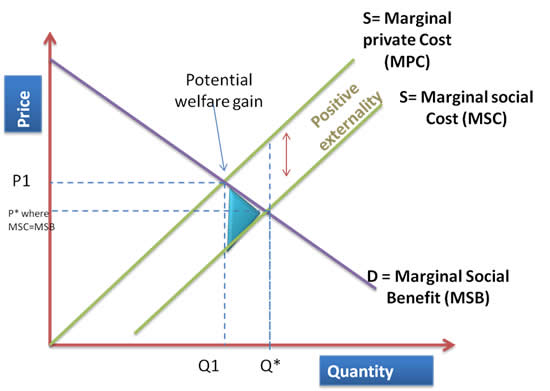
Corrective positive production externalities
Subsidies can be provided to firms which produce these goods. The effect will be the lowering of MPC and thus the MPC will more downward to MSC. This will increase the output to a level Q2 near to the socially optimal level Q*. The price will also fall from P1 to P2.
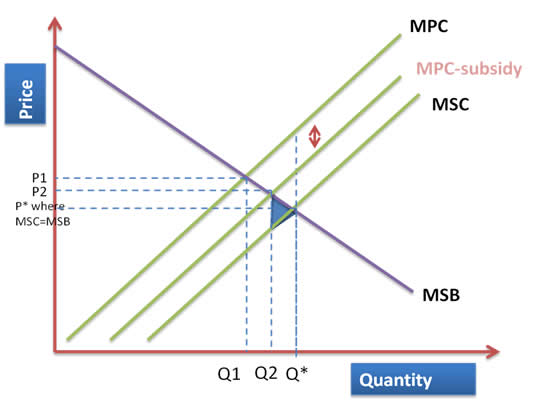
Watch a Video
Positive consumption externalities
Positive consumption externalities occur when there is a positive externality created by the consumption of certain goods.
Examples include consumption of education and health care. Both these will lead to more productive workforce and hence high rate of economic growth for the society.
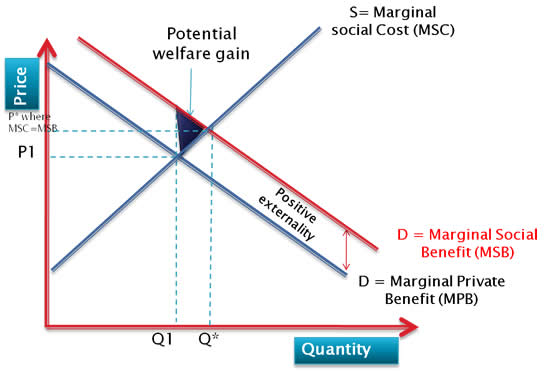
As the diagram illustrates, the MSB lies above the MPB and the difference between the two consists of positive externality. The socially optimal level is where MSB=MSC i.e Q*, however, due to under-allocation of resources the output/consumption is at Q1.
Corrective Positive consumption externalities
Subsidies
By giving subsidies to the producers of the good with the positive externality will result in increasing supply and shifting the supply curve downwards. This will lead to MSC curve shifting to MSC+subsidy which means high output/consumption at socially optimal level Q* and at lower prices from P1 to P*.
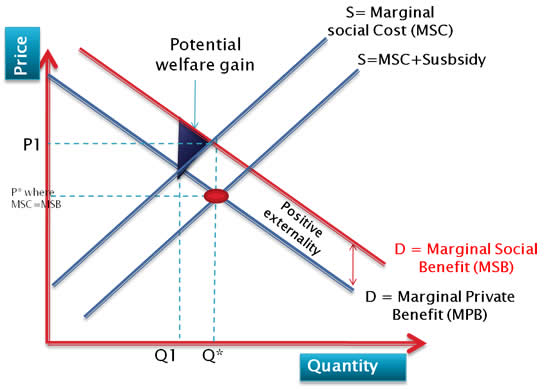
Advertising
Through positive advertising government can persuade consumers to increase their consumption and thus lead to a shift of MPB to the right i.e. increase in demand. If the MPB curve shifts enough, it will coincide with MSB and Q* will be produced and consumed.
